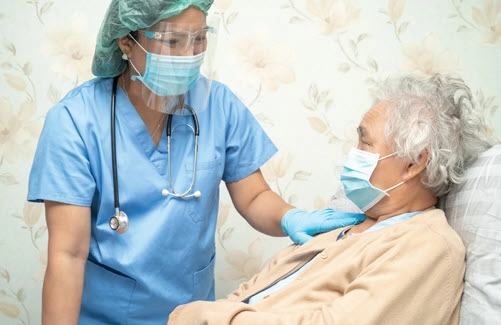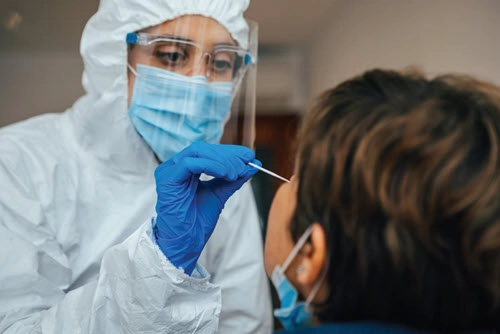Maintain Compliance and Fulfill Testing Requirements Using These Options
Plus, more advice for managing unvaccinated staff. The Centers for Medicare & Medicaid Services (CMS) is now acknowledging that facilities are fighting different pandemics depending on where they’re located in the country, with revised guidelines released as memorandum QSO-20-38-NH. Some facilities are in communities with very high rates of transmission, and obviously their day-to-day experiences differ from those in mostly vaccinated places. CMS’ new guidance provides facilities with options to remain compliant without spending unnecessary money. This guidance is especially helpful for facilities worried about money, but a new study from a nursing home in France shows that vaccination alone is not a complete bulwark against outbreaks. Test Regularly and Swiftly Nursing homes now have options when it comes to testing residents and staff. Although testing requirements have been monitored by state survey agencies since the publication of Ftag F886 COVID-19 Testing, the CMS has adjusted the guidelines to better reflect what an individual facility may be dealing with. Obviously, you want to stay ahead of any potential outbreaks or curb any active outbreaks. Testing symptomatic residents or staff immediately, regardless of vaccination status, is important, says David R. Wright, director of the survey and certification group at CMS. Surveyors will be checking that all facilities are testing — and following the necessary standards regarding frequency, identification of symptomatic and/or positive people, testing asymptomatic people if warranted by the facility’s county’s positivity rate, and responding to test results with actions that help prevent and control infection transmission. Surveyors are also instructed to look at documentation, making sure that every single test and its results are recorded. Remember: Residents can decline testing, so if that happens, just document that testing was offered. But make sure you have specific protocols in place, especially for residents who have signs or symptoms and refuse testing. Place them on transmission-based protocols until the individual’s status meets the criteria for discontinuing the protocols. “If outbreak testing has been triggered and an asymptomatic resident refuses testing, the facility should be extremely vigilant, such as through additional monitoring, to ensure the resident maintains appropriate distance from other residents, wears a face covering, and practices effective hand hygiene until the procedures for outbreak testing have been completed,” Wright says. Surveyors will also be checking that facilities have plans in place to prevent transmission, including keeping individual staff out of contact with other staff or residents until they receive a negative test — or, if they’re symptomatic but receive a negative COVID-19 test, having protocols in place to prevent transmission of other disease beyond COVID-19. If all of these testing requirements seem overwhelming to manage, don’t forget that you can always reach out to your state and local health departments for assistance. But the facility must have point of care (POC) testing and, at the minimum, a Clinical Laboratory Improvement Amendments (CLIA) certificate of waiver. You can find out more about a CLIA waiver here www.cms.gov/Regulations-and-Guidance/Legislation/CLIA/Downloads/HowObtainCertificateofWaiver.pdf. Note: Surveyors can cite a facility with F886 for concerns specific to COVID-19 testing, but they can also investigate or cite facilities for their transmission-based protocols under F880. You Find a Positive Test, Now What? If a staff member or resident tests positive, you need to start testing more people immediately. CMS now provides more options for your testing strategy: “broad-based” facility-wide testing or contact tracing, Wright says in the new guidance. “If the facility has the ability to identify close contacts of the individual with COVID-19, they could choose to conduct focused testing based on known close contacts. If a facility does not have the expertise, resources, or ability to identify all close contacts, they should instead investigate the outbreak at a facility-wide or group-level (e.g., unit, floor, or other specific area(s) of the facility). Broader approaches might also be required if the facility is directed to do so by the jurisdiction’s public health authority, or in situations where all potential contacts are unable to be identified, are too numerous to manage, or when contact tracing fails to halt transmission,” he says. Don’t lean on repeat testing of an individual who has tested positive a signal to end transmission-based protocols or work restrictions if the individual is a member of staff. Instead, go by the person’s symptoms and follow the CDC’s recommendations. You can find more information that applies to healthcare personnel here, www.cdc.gov/coronavirus/2019-ncov/hcp/guidance-risk-assesment-hcp.html, and to residents here, www.cdc.gov/coronavirus/2019-ncov/hcp/infection-control-recommendations.html. If a symptomatic unvaccinated staff member refuses testing, the facility must have procedures in place to ensure that they cannot enter the building until their condition meets the return-to-work criteria. If a facility is conducting outbreak testing and a staff member refuses testing, the individual should not enter the building until the outbreak testing is complete. Look to your occupational health and local jurisdiction policies for next steps on handling asymptomatic unvaccinated staff who refuse testing, Wright says. Think of 3 As a Magic Number If a resident or staff member has had COVID-19 and recovered, make sure you note the day of symptom onset. CMS says that, generally, asymptomatic residents and staff who have recovered from COVID-19 do not need to be retested within three months of this onset date. Facilities aren’t required to test folks visiting residents, but they may. “Facilities should prioritize resident and staff testing and have adequate testing supplies to meet required testing, prior to testing resident visitors,” Wright says.


